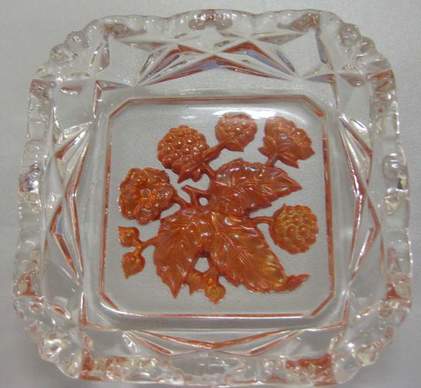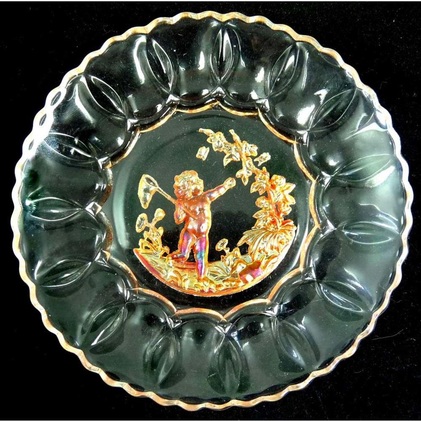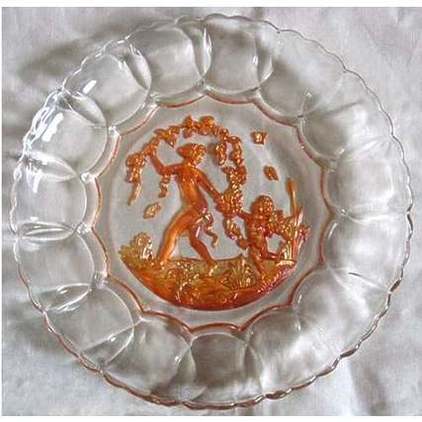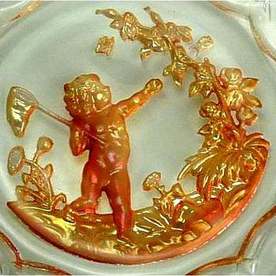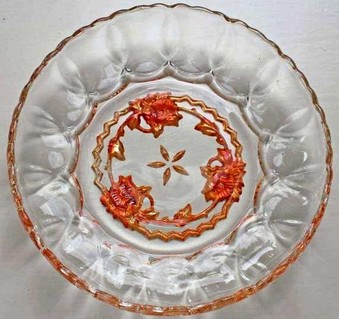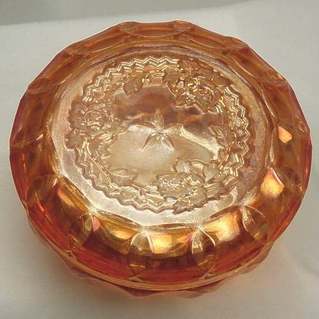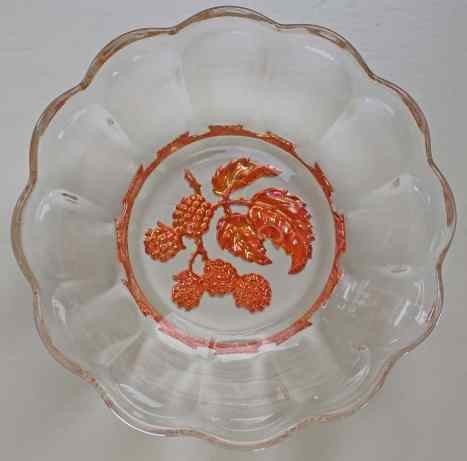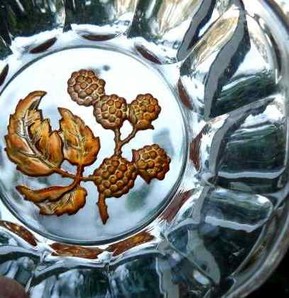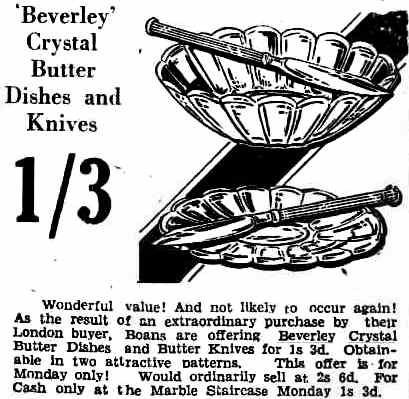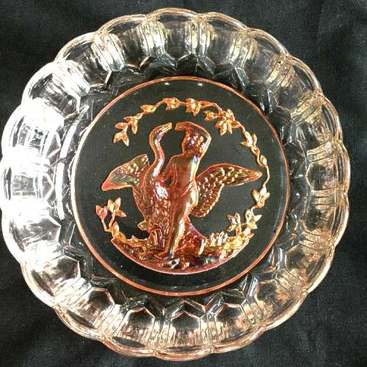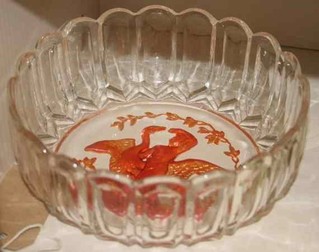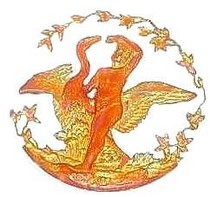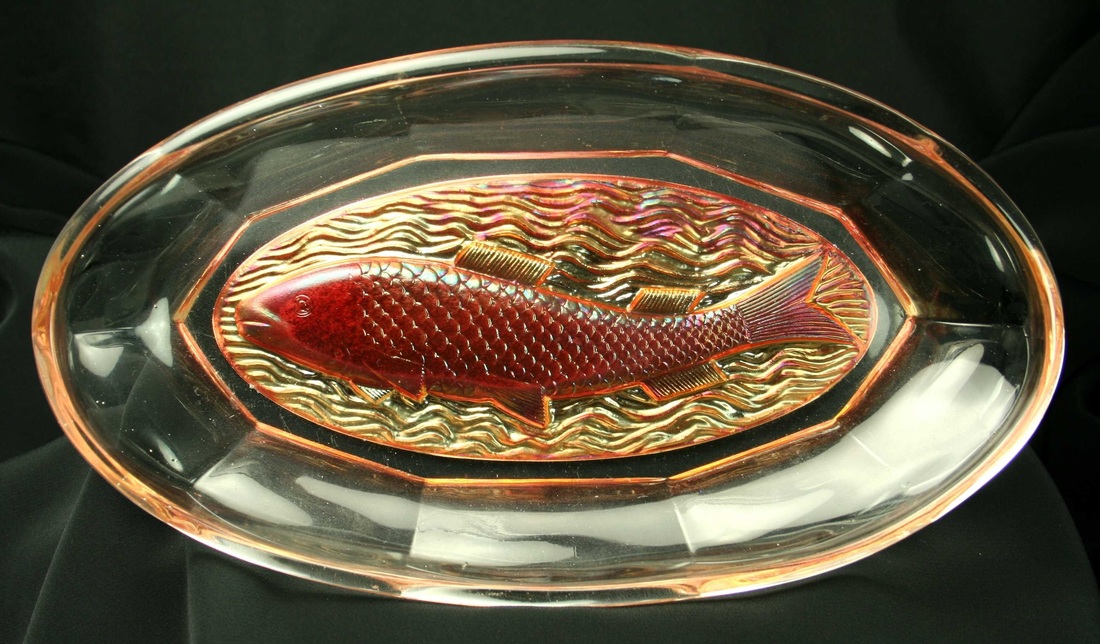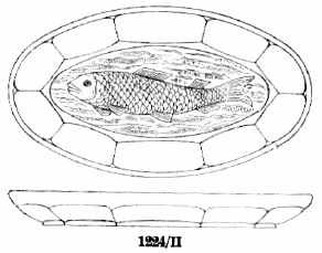Golden Treasures Part One
During our extensive research over many years into Carnival Glass made in Europe, we were intrigued by the so-called "Golden" Patterns, and the various - and different - attributions that had been made as to which company made them. Definitive proof was missing, and we were determined to find it!
Our research lead us towards the Zabkowice factory in Poland. The Zabkowice glass works in Silesia, Poland was built by the Czech glass maker, Josef Schreiber Jnr., in 1883 with production beginning in 1884. By the 1920s-1930s and the years leading up to World War II, Zabkowice was the biggest and most important glass works in Poland for household glass. They remained in operation until around 2005.
We have studied several Zabkowice catalogues (which confirmed our attributions) and, before the business closed, we were able to make contact and to correspond with them regarding the production of iridised items. Finally, we were able to show that Zabkowice made significant amounts of Carnival Glass, including not only some of the wonderful “Golden” patterns, but also the rare and unique Renaissance Egg.
Investigation into production by other factories in Poland has also been carried out by British researcher John Hodgson, and many more examples of Carnival have recently been identified thanks to intensive collaboration between researchers. Our thanks to John for his research and support regarding Polish Carnival and the Golden Patterns, and also to Malcolm and Hilary Ross.
The Golden Patterns
Zabkowice produced most of the “Golden” designs that we know of. Although other Polish makers are thought to have made some “Golden” pieces, we do not, so far, have any positive attribution. Zabkowice's glass was sold in Australia and some other countries under the name Beverly Crystal (sometimes spelled Beverley). Interestingly, many of the “Golden” pieces have been found in Australia (they were imported from Poland) – in fact until our research into these patterns, the country of manufacture was often speculated to have been Australia!
The "Golden" Patterns have intaglio design motifs that are moulded into the underside of the base. The motifs are iridised and the surrounding glass is clear - sometimes (rarely) it is a very pale pink base glass. It’s interesting to note that some of these Golden Patterns are also known in reverse decoration (with marigold iridescence surrounding the design and the motifs are clear). Most of these items have pattern names that are prefixed with the word “Golden” (for example Golden Days) while others have names that don’t automatically suggest their inclusion (for example Diana The Huntress).
Ring-Around
Ring-Around is a known Zabkowice pattern. It is found on a number of the "Golden" designs, but not all of them. Therefore, where it is present (as a secondary pattern), Ring-Around confirms our attribution to Zabkowice. It is a moulded design of interlocking or overlapping circles around the perimeter of the item surrounding the iridised design - see Butterfly Catcher for an example of Ring-Around.
The currently known "Golden" patterns that feature Ring-Around are: Butterfly Catcher, Circled Rose, Golden Poppies Variant, Golden Zigzag and Snowflake.
Ring-Around is not the only secondary pattern: there are several other confirmed Zabkowice designs (as shown in the various patterns on these pages).
Zabkowice produced most of the “Golden” designs that we know of. Although other Polish makers are thought to have made some “Golden” pieces, we do not, so far, have any positive attribution. Zabkowice's glass was sold in Australia and some other countries under the name Beverly Crystal (sometimes spelled Beverley). Interestingly, many of the “Golden” pieces have been found in Australia (they were imported from Poland) – in fact until our research into these patterns, the country of manufacture was often speculated to have been Australia!
The "Golden" Patterns have intaglio design motifs that are moulded into the underside of the base. The motifs are iridised and the surrounding glass is clear - sometimes (rarely) it is a very pale pink base glass. It’s interesting to note that some of these Golden Patterns are also known in reverse decoration (with marigold iridescence surrounding the design and the motifs are clear). Most of these items have pattern names that are prefixed with the word “Golden” (for example Golden Days) while others have names that don’t automatically suggest their inclusion (for example Diana The Huntress).
Ring-Around
Ring-Around is a known Zabkowice pattern. It is found on a number of the "Golden" designs, but not all of them. Therefore, where it is present (as a secondary pattern), Ring-Around confirms our attribution to Zabkowice. It is a moulded design of interlocking or overlapping circles around the perimeter of the item surrounding the iridised design - see Butterfly Catcher for an example of Ring-Around.
The currently known "Golden" patterns that feature Ring-Around are: Butterfly Catcher, Circled Rose, Golden Poppies Variant, Golden Zigzag and Snowflake.
Ring-Around is not the only secondary pattern: there are several other confirmed Zabkowice designs (as shown in the various patterns on these pages).
|
Breaking News - a newly discovered Golden pattern! Golden Blackberry With Flowers, Zabkowice. This golden design features what appear to be blackberries, leaves and five-petalled blackberry flowers. It is the first item reported in this design. Found in Australia, photo courtesy Lesley Smith, and thanks to Dennis for permission to show it. The surrounding moulded design provides the confirmed attribution to Zabkowice: it is a known Beverley Crystal / Zabkowice pattern, which has been found with the Golden Thistle design in the centre (see Part Four of Golden Treasures.) |
Part One, this page: Butterfly Catcher, Circled Rose, Golden Blackberry, Golden Boy With Swan and Golden Carp
In Part Two: Golden Cupid, Diana the Huntress, Golden Days, Golden Fruit and Golden Lobster
In Part Three: Golden Pansy/Pansy in Reverse, Golden Pansy and Leaves, Golden Pineapple and Golden Poppies and Variant
In Part Four: Golden Rover, Golden Square, Golden Thistle, Golden Zigzag and Snowflake
Butterfly Catcher, Zabkowice.
|
The Butterfly Catcher design is exceptionally detailed: it is in marigold, and the rest is clear. The base is also ground and highly polished. Although the two plates pictured above have different designs, we believe they were part of the same "set" - as "master" and smaller "side" plates which were intended to be used together. The designs are complementary and they both have the same moulded pattern around the perimeter of the plates - a design of interlocking or overlapping circles on the surrounding clear glass that is called Ring-Around. Our research has established that the Ring-Around pattern was made by Zabkowice, Poland, and it is shown in their catalogues. On account of this, we are confident in attributing the Butterfly Catcher to Zabkowice. The Ring-Around pattern has also been instrumental in confirming other "Golden" patterns as items made by Zabkowice. |
Circled Rose, Zabkowice.
The moulded pattern of interlocking circles on the encircling clear glass is called Ring-Around, and it is shown in Zabkowice catalogues, thus providing the attribution. The central golden rose pattern is one of several different floral designs from this maker, and is found in large and small bowls, a handled dish and a covered bonbonniere.
Found in marigold and clear, in two ways: the true "Golden" pattern where the circled rose pattern is marigold and the rest of the piece is clear - shown below left, and also in reverse where the rose pattern is clear and the rest of the piece is marigold, as in the lid of the bonbonniere shown below right.
The moulded pattern of interlocking circles on the encircling clear glass is called Ring-Around, and it is shown in Zabkowice catalogues, thus providing the attribution. The central golden rose pattern is one of several different floral designs from this maker, and is found in large and small bowls, a handled dish and a covered bonbonniere.
Found in marigold and clear, in two ways: the true "Golden" pattern where the circled rose pattern is marigold and the rest of the piece is clear - shown below left, and also in reverse where the rose pattern is clear and the rest of the piece is marigold, as in the lid of the bonbonniere shown below right.
Golden Blackberry, Zabkowice. Also known as Golden Blackberries and Golden Berry.
Our belief that this was a Zabkowice item was confirmed when we found the ad shown (above right) in a 1931 Australian newspaper. The encircling, moulded pattern on the clear glass section of the Golden Blackberry is identical to that on the dishes shown in the ad, which is for Beverley Crystal glass (the marketing name in Australia for Zabkowice).
Currently Golden Blackberry is known in small plate and bowl shapes, although larger versions are likely. The item shown here is a 6" plate.
Golden Boy With Swan, Zabkowice. Also known as "Goose Girl", "Leda and the Swan" and "Joseph and the Swan".
Currently Golden Blackberry is known in small plate and bowl shapes, although larger versions are likely. The item shown here is a 6" plate.
Golden Boy With Swan, Zabkowice. Also known as "Goose Girl", "Leda and the Swan" and "Joseph and the Swan".
|
Golden Boy With Swan (above) courtesy of Richard Cinclair.
The pattern is also known as "Joseph and the Swan" This is a definite Zabkowice item - the moulded design on the clear part of the piece is shown in Zabkowice catalogues and it is the same as the one that is also seen on Diana the Huntress. Small (6") straight sided bowls are the only shape currently known. |
Golden Carp, Zabkowice.
An intaglio fish design on a low oval bowl (as above) appears in the catalogues of both the Polish makers, Hortensja and Zabkowice. Close study shows that the surrounding moulded pattern (of panels) matches the Zabkowice catalogue exactly, (the Hortensja design has pronounced double lines between each panel – the Zabkowice design has a single, soft line, as on the glass itself).
These dishes were intended to hold herrings.
These dishes were intended to hold herrings.
More Golden Patterns in Golden Treasures Part Two

